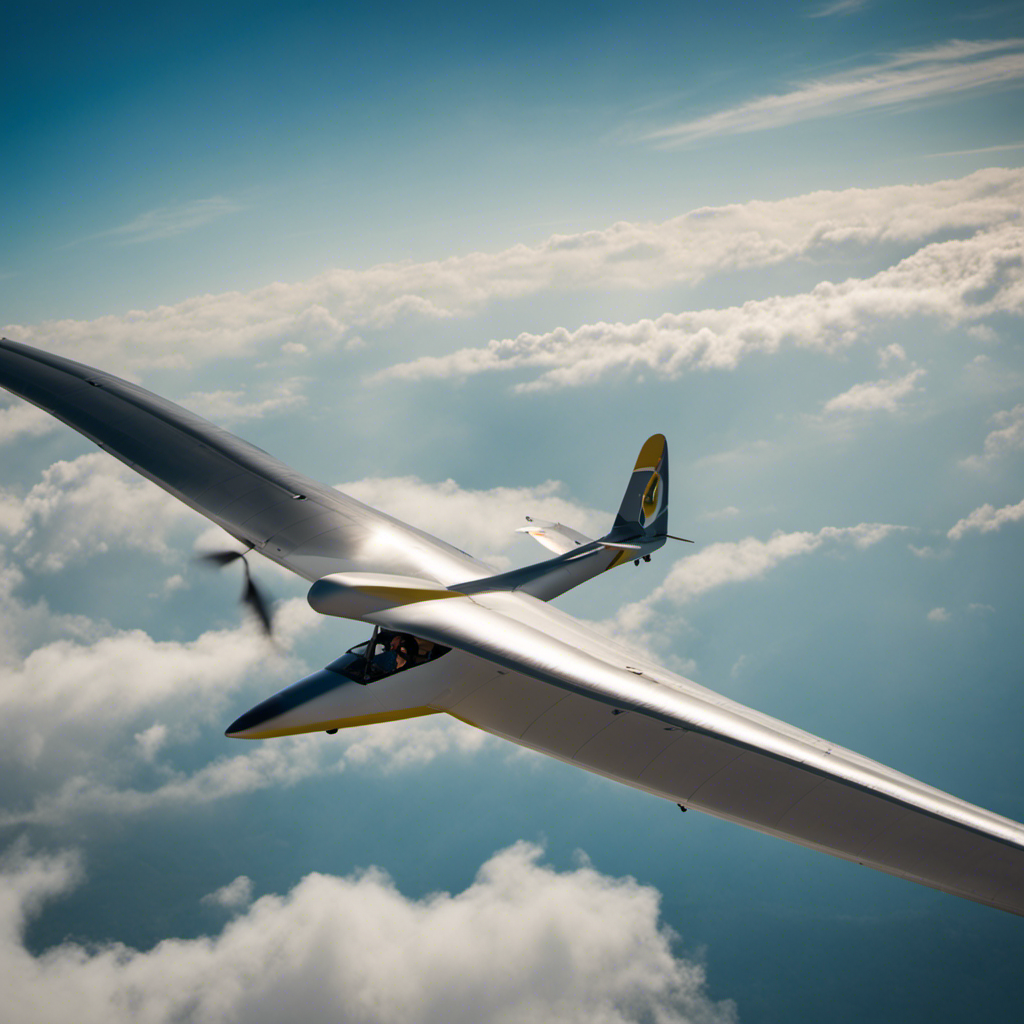As an experienced glider, I want to share with you the importance of gliding safety for beginners.
Gliding can be an exhilarating and rewarding experience, but it’s crucial to prioritize safety from the start. In this article, I will guide you through the basics of gliding safety, including essential equipment, preparation tips, and common mistakes to avoid.
We will also delve into emergency procedures and safety protocols, ensuring that you have the knowledge and confidence to enjoy a safe gliding adventure.
Key Takeaways
- Gliding safety regulations ensure the well-being of all pilots and passengers.
- Pre-flight checks are essential to identify potential issues or malfunctions.
- Understanding emergency procedures and safety protocols is crucial.
- Proper training equips beginners with necessary safety skills.
Understanding the Basics of Gliding Safety
Understanding the basics of gliding safety is crucial for all beginners. Gliding safety regulations are put in place to ensure the well-being of all glider pilots and passengers. These regulations outline the necessary safety procedures and guidelines that must be followed during every gliding activity.
One important aspect of gliding safety is the importance of pre-flight checks. Before every flight, it is essential to thoroughly inspect the glider to ensure its airworthiness. This includes checking the control surfaces, the integrity of the wings, the condition of the landing gear, and the functionality of the instruments and avionics. It is important to identify any potential issues or malfunctions before taking off to prevent any accidents or emergencies during the flight.
Additionally, pre-flight checks also involve assessing the weather conditions and airspace restrictions. Glider pilots need to be aware of any potential hazards such as strong winds, thunderstorms, or restricted areas. By being knowledgeable about the weather and airspace conditions, pilots can make informed decisions and avoid unnecessary risks.
Essential Safety Equipment for Gliding Beginners
Make sure you have the essential safety equipment, like a helmet and a parachute, before you start gliding. Safety regulations for gliding beginners are put in place to ensure your well-being during the flight.
Here are four important safety regulations to keep in mind:
-
Helmet: A helmet is crucial to protect your head from any potential impact during takeoff, landing, or turbulence. It should fit properly and be securely fastened.
-
Parachute: A parachute is your ultimate safety device in case of an emergency. It allows you to safely descend to the ground if you need to abandon the glider. Make sure it is in good condition and regularly inspected.
-
Safety harness: A safety harness keeps you securely fastened to the glider, preventing any accidental falls or ejections. Always double-check the harness before each flight to ensure it is properly secured.
-
Radio communication device: A radio communication device allows you to stay in contact with the ground crew and other gliders. This is essential for receiving important information, such as weather updates or instructions during emergencies.
Proper training in gliding safety is of utmost importance. It equips you with the necessary skills to handle various situations and navigate safely through the sky. Remember, safety should never be compromised when it comes to gliding. So always be prepared and prioritize your well-being.
Preparing for a Safe Gliding Experience
Before you start gliding, it’s important to prepare for a safe experience by following these guidelines.
One of the most crucial aspects of gliding safety is making proper pre-flight preparations. This includes checking the glider’s overall condition, ensuring all equipment is functioning correctly, and verifying that the required documentation is up to date.
It’s also essential to assess the weather conditions before taking off. Weather plays a significant role in gliding, as it affects the stability and performance of the glider. Pay attention to wind direction and speed, as well as any potential changes in weather patterns. Keep in mind that gliding should not be attempted in adverse weather conditions, such as strong winds, thunderstorms, or low visibility.
Additionally, familiarize yourself with the local airspace regulations and any specific requirements or restrictions in place.
Common Safety Mistakes to Avoid in Gliding
One of the most common safety mistakes to avoid in gliding is neglecting to thoroughly check the glider’s overall condition before taking off. This is crucial because any malfunction or damage to the glider can put both the pilot and passengers at risk.
Here are four important points to keep in mind when it comes to gliding safety:
-
Proper body positioning during gliding: Maintaining the correct body position is essential for stability and control. This includes sitting upright, keeping your feet on the pedals, and holding the control stick firmly but not too tightly.
-
Importance of weather conditions in gliding safety: Weather conditions play a significant role in gliding safety. It’s crucial to check the forecast and avoid flying in adverse conditions such as strong winds, thunderstorms, or low visibility.
-
Regular maintenance and inspection: Regularly inspecting the glider and ensuring it is in good working condition is vital. This includes checking the control surfaces, cables, and instruments before each flight.
-
Pre-flight briefing: Before taking off, it is essential to receive a thorough pre-flight briefing from an experienced instructor. This briefing should cover emergency procedures, safety protocols, and any specific considerations for the day’s flight.
By following these safety measures, you can significantly reduce the risk of accidents and ensure a safe gliding experience.
Now, let’s explore the emergency procedures and safety protocols in gliding.
Emergency Procedures and Safety Protocols in Gliding
To ensure your safety while gliding, familiarize yourself with the emergency procedures and safety protocols in place. In the event of an emergency landing, it’s crucial to know how to handle the situation calmly and effectively. Here are some key emergency procedures and safety protocols to keep in mind:
| Emergency Landing | Communication Procedures |
|---|---|
| Assess the situation and choose a suitable landing spot. | Use the designated emergency frequency to communicate with air traffic control or other gliders in the area. |
| Prepare for landing by securing loose objects and adjusting your position in the cockpit. | Clearly state your intentions and provide relevant information about your location, altitude, and emergency situation. |
| Maintain control of the glider and follow the appropriate landing technique. | Listen carefully to instructions from air traffic control or other pilots and follow their guidance. |
| Once on the ground, shut off the glider’s electrical systems and exit the aircraft safely. | Stay in communication with ground support personnel or emergency services to ensure timely assistance if needed. |
| Report the incident to the appropriate authorities and provide any necessary details for investigation. | Follow any additional communication procedures outlined by your gliding club or organization. |
Frequently Asked Questions
How Long Does It Take to Become a Certified Glider Pilot?
Becoming a certified glider pilot requires a significant investment of time and dedication. The training process involves learning the necessary skills and knowledge to ensure gliding safety.
While the exact time requirements may vary depending on individual progress and available training opportunities, it typically takes several months to a year to complete the necessary training and obtain certification.
It is important for beginner glider pilots to prioritize safety and thoroughly understand the requirements and responsibilities of becoming certified.
What Are the Most Common Injuries Sustained During Gliding?
The most common injuries sustained during gliding include sprains, strains, and fractures.
It’s important to prioritize safety precautions to minimize the risk of these injuries. By following proper training, using appropriate equipment, and being aware of weather conditions, gliders can reduce the likelihood of accidents.
Gliding safety is a crucial aspect of the sport and should be taken seriously by all pilots.
Are There Any Age Restrictions for Gliding?
Age restrictions for gliding vary depending on the country and the type of glider. Safety measures for beginners are essential regardless of age. It is important to undergo proper training and follow guidelines to ensure a safe gliding experience.
Instructors will assess an individual’s physical and mental capabilities before allowing them to participate. Safety precautions such as wearing appropriate gear, understanding weather conditions, and following proper landing procedures are crucial for all gliders, regardless of age.
Can Gliding Be Done in Bad Weather Conditions?
Gliding in bad weather conditions can be both thrilling and dangerous. The pros include the opportunity to test your skills and experience the adrenaline rush of flying in challenging conditions. However, there are important safety precautions to consider.
It’s crucial to check weather forecasts, assess wind conditions, and ensure you have proper training and equipment. Gliding in bad weather requires extra caution and expertise to mitigate risks and ensure a safe flight.
Is It Necessary to Have Previous Flying Experience Before Learning to Glide?
No, it isn’t necessary to have previous flying experience before learning to glide. However, it is important to take safety precautions and receive proper training.
Gliding is a unique skill that can be learned by anyone with the right instruction and dedication. It is crucial to follow all safety guidelines and guidelines set by experienced gliders and instructors.
With the right guidance, anyone can learn to glide safely and enjoy this thrilling sport.
Conclusion
In conclusion, gliding is a thrilling and exhilarating experience that can be enjoyed by beginners. By understanding the basics of gliding safety, equipping ourselves with the necessary safety gear, and following proper protocols, we can ensure a safe and enjoyable gliding adventure.
Remember, safety is like the wind beneath our wings, guiding us through the skies. So spread your wings, embrace the freedom, and soar high with confidence, knowing that you have the knowledge and tools to keep yourself safe.
Happy gliding!




